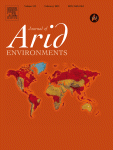Ver ítem
- xmlui.general.dspace_homeCentros Regionales y EEAsCentro Regional Mendoza - San JuanEEA MendozaArtículos científicosxmlui.ArtifactBrowser.ItemViewer.trail
- Inicio
- Centros Regionales y EEAs
- Centro Regional Mendoza - San Juan
- EEA Mendoza
- Artículos científicos
- Ver ítem
Germination of six native perennial grasses that can be used as potential soil cover crops in drip-irrigated vineyards in semiarid environs of Argentina
Resumen
Native desert plants have structural adaptations that maximize photosynthesis rates and minimize water loss. They can be successfully utilized as soil cover crops in drip-irrigated vineyards where water availability is low. The objective of this paper is to study seed germination conditions and to recommend which best species is most apt as soil cover crop in drip-irrigated vineyards. Seed weight (the higher the seed weight, the greater the success of
[ver mas...]
Native desert plants have structural adaptations that maximize photosynthesis rates and minimize water loss. They can be successfully utilized as soil cover crops in drip-irrigated vineyards where water availability is low. The objective of this paper is to study seed germination conditions and to recommend which best species is most apt as soil cover crop in drip-irrigated vineyards. Seed weight (the higher the seed weight, the greater the success of mechanical seeding) and germination tests (at 15, 20, 25, 30, and 35 °C in light and dark conditions) were carried out for six species native to Mendoza, Argentina. Germination percentage (GP) and mean time germination (MTG) were calculated. Digitaria californica (C4) had the highest GP (97% in light condition), which is recommended as a cover crop because of its seed germination potential. Pappophorum phillippianum (C4) had a 70% GP in light conditions (regardless of temperature) and a high seed weight. Leptochloa dubia (C4) and Sporobolus cryptandrus (C4) reached the highest GP at the highest temperature, although S. cryptandrus had the lowest seed weight. Nassella tenuis (C3) averaged 54% GP at 25 °C in light conditions. The GP of Setaria leucopila (C4) was not affected by temperature (26% in light, and 16% in darkness). Based on the GP results, S. leucopila was the worst choice of the six species. Hence, during seeding, soil temperature should be high (>20 °C) to ensure a rapid plant establishment of all species.
[Cerrar]

Fuente
Journal of Arid Environments 113 : 1-5 (February 2015)
Fecha
2015-02
ISSN
0140-1963
Formato
pdf
Tipo de documento
artículo
Palabras Claves
Derechos de acceso
Restringido
 Excepto donde se diga explicitamente, este item se publica bajo la siguiente descripción: Creative Commons Attribution-NonCommercial-ShareAlike 2.5 Unported (CC BY-NC-SA 2.5)
Excepto donde se diga explicitamente, este item se publica bajo la siguiente descripción: Creative Commons Attribution-NonCommercial-ShareAlike 2.5 Unported (CC BY-NC-SA 2.5)

